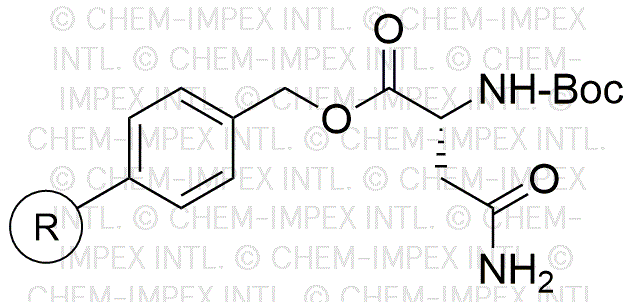Na-Boc-D-asparagine Merrifield is widely utilized in research focused on
- Peptide Synthesis: This compound serves as a key building block in the synthesis of peptides, allowing researchers to create complex structures for various biological studies.
- Drug Development: Its application in drug design helps in the development of pharmaceuticals targeting neurological disorders, enhancing therapeutic efficacy.
- Bioconjugation: Used in bioconjugation techniques, it aids in attaching biomolecules to surfaces or other molecules, which is crucial for creating targeted drug delivery systems.
- Protein Engineering: This compound is essential in protein engineering, facilitating the modification of proteins to study their functions and interactions in cellular processes.
- Research in Neurobiology: It plays a significant role in neurobiology research, particularly in studying the effects of aspartate on neurotransmission and synaptic plasticity.
General Information
Properties
Safety and Regulations
Applications
Na-Boc-D-asparagine Merrifield is widely utilized in research focused on
- Peptide Synthesis: This compound serves as a key building block in the synthesis of peptides, allowing researchers to create complex structures for various biological studies.
- Drug Development: Its application in drug design helps in the development of pharmaceuticals targeting neurological disorders, enhancing therapeutic efficacy.
- Bioconjugation: Used in bioconjugation techniques, it aids in attaching biomolecules to surfaces or other molecules, which is crucial for creating targeted drug delivery systems.
- Protein Engineering: This compound is essential in protein engineering, facilitating the modification of proteins to study their functions and interactions in cellular processes.
- Research in Neurobiology: It plays a significant role in neurobiology research, particularly in studying the effects of aspartate on neurotransmission and synaptic plasticity.
Documents
Safety Data Sheets (SDS)
The SDS provides comprehensive safety information on handling, storage, and disposal of the product.
Product Specification (PS)
The PS provides a comprehensive breakdown of the product’s properties, including chemical composition, physical state, purity, and storage requirements. It also details acceptable quality ranges and the product's intended applications.
Certificates of Analysis (COA)
Search for Certificates of Analysis (COA) by entering the products Lot Number. Lot and Batch Numbers can be found on a product’s label following the words ‘Lot’ or ‘Batch’.
*Catalog Number
*Lot Number
Certificates Of Origin (COO)
This COO confirms the country where the product was manufactured, and also details the materials and components used in it and whether it is derived from natural, synthetic, or other specific sources. This certificate may be required for customs, trade, and regulatory compliance.
*Catalog Number
*Lot Number
Safety Data Sheets (SDS)
The SDS provides comprehensive safety information on handling, storage, and disposal of the product.
DownloadProduct Specification (PS)
The PS provides a comprehensive breakdown of the product’s properties, including chemical composition, physical state, purity, and storage requirements. It also details acceptable quality ranges and the product's intended applications.
DownloadCertificates of Analysis (COA)
Search for Certificates of Analysis (COA) by entering the products Lot Number. Lot and Batch Numbers can be found on a product’s label following the words ‘Lot’ or ‘Batch’.
*Catalog Number
*Lot Number
Certificates Of Origin (COO)
This COO confirms the country where the product was manufactured, and also details the materials and components used in it and whether it is derived from natural, synthetic, or other specific sources. This certificate may be required for customs, trade, and regulatory compliance.


